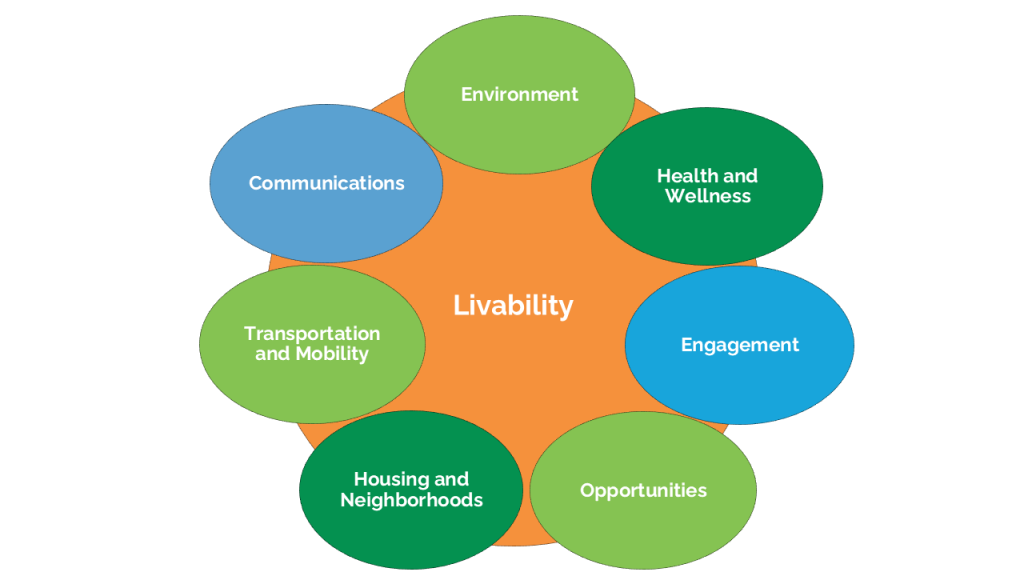RURAL COMMUNITY DEVELOPMENT THROUGH A LIVABILITY LENS
Our Focus of Concern
With increasing frequency, the concept of Livability serves a consequential purpose in both community planning activities and in policy development. AARP, an organization that has actively promoted livability, has issued the following policy statement on the subject.
A Livable Community is safe and secure, has affordable and appropriate housing and transportation options, and offers supportive community features and services. Once in place, those resources enhance personal independence, allow residents to age in place, and foster their engagement in the community’s civic, economic and social life.
AARP Policy book
While a review of the literature suggests that there are some variations in how this concept is defined and interpreted, there is general agreement that a community’s livability status can:
- Reveal areas of strength and challenge,
- Help shape action planning based on these same variables,
- Determine how action plan implementation is monitored and subsequently adjusted, as needed, and
- Influence how outcomes evaluation of impact, effectiveness, and sustainability is conducted and implemented in moving forward.
Given its mission to provide research-based strategies to Extension professionals who specialize in rural community development, the WRDC is well-positioned to engage in content validation of a proposed model of livability for use by these same specialists. A critical first step toward validation of such a frame of reference for use by city planners would be to establish a relationship between issues encountered in the field and how livability might be defined.
Partners in the Process
In pursuit of this objective, WRDC conducts literature reviews on the subject, surveys, and initiate conversations with selected authorities across the Western Region.
Organizing focus groups with the help of WRDC
A first focused group comprised of experts in rural community development was convened on Wednesday May 21st 2025. Specialists from the West critically reviewed existing variables associated with livability to determine how well these items capture the challenges faced at the local rural community level. The seven variables that underpin AARP’s Livability Index and their 8 Domains of Livability was used to structure those measures employed for content validation purposes.
Having validated a frame of reference for potential use in the field, generate a livability graphic that is reflective of both the challenges encountered and illustrative of how livability might be described in detail.

Drawing from definitional elements associated with each of these variables and those variable-specific descriptors provided by subject matter specialists, WRDC will further develop these same components through inquiries with selected Extension specialists, subject matter experts, and other authorities across the Western Region.
WRDC will identify best practices in:
- Building leadership/support systems at the local community level,
- Diagnosing livability status using the framework (with descriptors) illustrated above and taking a mixed methodological approach to community assessment,
- Developing livability status-driven action plans that incorporate provisions for monitoring progress, and
- Determining overall impact, effectiveness, and sustainability as an outcomes evaluation of programming through Western Region Extension specialists.
In pursuit of these objectives, Extension specialists in the community development field will be interviewed both individually and/or through focus group inquiries as to exemplary operational practices they have observed in the field. In addition, meta-analyses of selected reports from member communities of the Network of Age-Friendly States and Communities will be conducted. Finally, in the spirit of inter-departmental collaboration, input from University subject matter experts who are well-grounded in community development practices will be collected.
Helpful resources (human, material, financial and political) that have proven (or promise) to be contributive at the local community development level will be identified and inventoried for eventual dissemination to the Extension Community and other affiliates with an interest in rural community development.
Outputs and Evaluation of Outcomes
With regard to delivery systems, WRDC will produce workbooks to accompany webinar(s) on topics related to optimizing livability status at the local community level via Extension practitioners. In addition, opportunities to present at various conferences, consult with members of the Western Region Extension community, and write for professional publications targeting appropriate audiences will be undertaken.
As a commitment to accountability, periodic process level evaluations designed to monitor progress made will be conducted at strategic points during implementation of delivery systems described above. This process will enable WRDC to make “mid-course corrections,” as needed. As product level measures, an impact evaluation to determine success in reaching intended audiences, an effectiveness evaluation intended to assess quality and significance of outcomes, and evaluations of sustainability and transportability, measures of durability over time and applicability elsewhere, respectively, will be undertaken.
